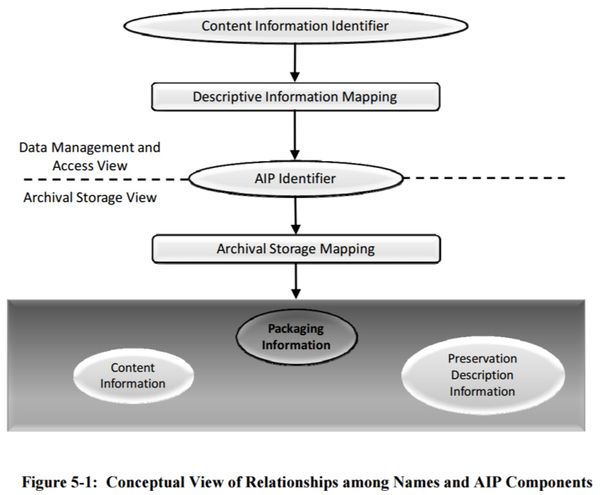5.1.2 MIGRATION CONTEXT
Community Forum | OAIS Community | OAIS Structure | OAIS Blog Posts | Active Topics and News
Key functional and information modeling concepts from section 4, as they relate to migration perspectives, are summarized in figure 5-1.
Figure 5-1: Conceptual View of Relationships among Names and AIP Components
The OAIS Consumer interface in Access provides one or more Content Information IDs, with associated name spaces, to assist in identifying a particular Content Information object of interest. One or more of these Content Information IDs will be included in the PDI Reference Information associated with that Content Information object. The Descriptive Information in Data Management will map each of these IDs to the same AIP ID. The Access Function uses this information to obtain the AIP ID and gives it to Archival Storage to retrieve the associated AIP.
Within Archival Storage, the AIP ID is mapped to the location of AIP Packaging Information by the Archival Storage mapping infrastructure. The AIP Packaging Information, in turn, logically delimits and identifies the Content Information and the PDI, and binds them into a single entity for preservation. For example, if the Content Information and PDI are determined to be the content of several files, the pointers to documents describing the representations of those files, and the documents themselves, then the Packaging Information would logically be defined as the implementation of the file system holding the file content bits, the data structure holding the pointers, the information which is used to distinguish the Content Information from the PDI, and an encapsulating data structure which identifies the files and other data structures as the components of the AIP Package. The associated Archival Storage mapping infrastructure might then be implemented as a database which relates the AIP ID to the location of the encapsulating data structure.
The transfer of any part of the Content Information, PDI, or Packaging Information to the same or new media, with the intent that it replaces that part of the previous AIP, is considered to be a Digital Migration of the AIP. A change to the Archival Storage mapping information only, which is outside of the AIP concept, is not considered to be a migration of the associated AIP, although such changes need to be carefully controlled to ensure that access to the AIP is maintained.
The ways in which AIPs are implemented will have a major influence on both the level of automation and the probability of information loss during migrations. Good AIP designs can both increase migration automation and reduce information loss probabilities. To better understand the impacts of these factors on AIP migrations it is useful to categorize migrations into several types and then to consider some issues associated with selected implementation approaches.
--Please retain original text above for reference. Propose amendments or additions below this line or respond using the Discussion tab above--
Community Forum | OAIS Community | OAIS Structure | OAIS Blog Posts | Active Topics and News
These wiki pages are licensed under a Creative Commons Attribution-NonCommercial 3.0 Unported License. Attribute as "Community forum for digital preservation and curation standards http://wiki.dpconline.org/". The content on this wiki represents the opinions of the author and not the Digital Preservation Coalition. This wiki is not associated with ISO, the OAIS Standard or the CCSDS.

